Environmentalists may not think highly of big, heavy-duty and powerful SUVs but there are more than a few reasons such models strike a chord with Indian buyers. These SUVs’ sheer size equals huge street cred, their hardy body-on-frame construction means they are built to take a beating and their large diesel engines give them the go to match the show. To many, these Rs 30-lakh SUVs are far more desirable than similar-priced luxury sedans.
The Ford Endeavour and Chevrolet Trailblazer are the newest entrants in the segment and both SUVs have plenty to impress with. Mitsubishi’s Pajero Sport is here as well and though not much more than a bit player today, it’s still a potent SUV that shouldn’t be ignored. Of course, we had to have the undisputed segment champion, the Toyota Fortuner too. For this comparison, we’ve considered the automatic transmission versions of these SUVs. Do note, the Pajero Sport in auto form and the Trailblazer are solely available in 4x2 guise while the Endeavour with the more powerful 3.2-litre engine used here comes with an auto ’box and four-wheel drive as standard. The Fortuner offers the most drivetrain options but it’s the one with the 3.0-litre engine, automatic gearbox and 4x4 that we’re interested in.
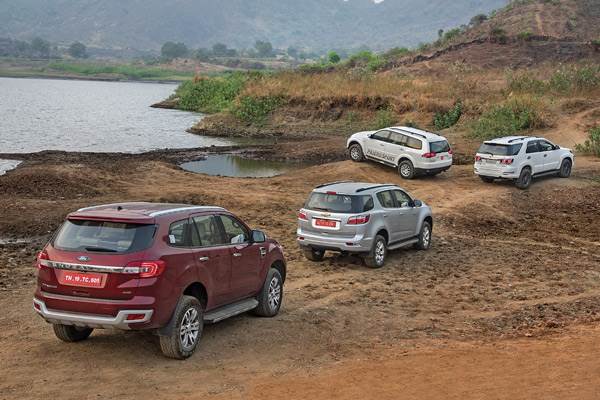
As always, the SUVs will be judged on a bunch of parameters like quality, overall comfort, performance and ease of use. Read on to find out about the best SUV.
High rises
Thanks to the way they are put together, body-on-frame SUVs sit high off the ground and that’s what you’ll see here. Each of these four SUVs looks tough and generally commands a lot of respect on our roads. See them together though and you’ll agree that it’s the Endeavour and Trailblazer that appear the most imposing; their chest-high bonnets have a lot to do with this.
The Ford looks like a proper yank tank and though styling is simple, the treatment is modern and attractive. Of the four, it’s the Endeavour that’ll get the most glances. Chevy’s Trailblazer doesn’t make as strong a first impression, but its smart looks do grow on you. Perhaps a bit more chrome detailing would have given it the necessary flash value. The Toyota Fortuner makes good use of the shiny stuff and the Land Cruiser resemblance at the front works well to this day. However, the rest of the design has started showing its age, something which you’ll note about the Pajero too. The tacky and oversized Pajero Sport stickers on the sides don’t do the Mitsubishi any favours either.
Command centre
Given how high-set their cabins are, you’ll have to haul yourself into each of these SUVs. Thankfully, all of them come with robust footboards that make ingress-egress that little bit easier. On the inside, it’s the Endeavour that feels far more modern and better finished than the others. The dash looks attractive, the soft leather finish on the dash top feels rich and the general choice of colours and materials elsewhere work well. The two screens in the instrument cluster and the large central touchscreen give the Ford’s cabin a cockpit-like feel. It’s well thought-out too with generous storage for smaller items and the front seats offer a good deal of support as well.
The Trailblazer’s cabin may be a distant second to the Ford’s on quality but here too, you get the feeling of sitting in a contemporary SUV. While the dash isn’t radical by any means, it does have its interesting bits in the Camaro-like hooded dials, round platform for the climate control system and unique twin glovebox arrangement, among other storage bays. Also, thanks to the dash being low-set, visibility is really good. The well-cushioned front seats that come finished in high-quality leather also do their bit to make the Chevy’s cabin feel inviting.
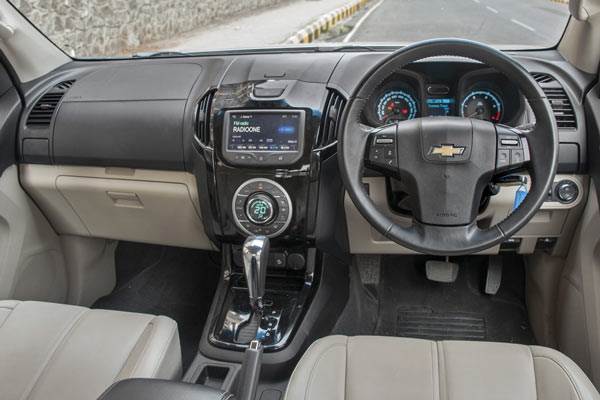
After some time in the Endy and Trailblazer, moving to the Pajero Sport and Fortuner is like taking a step back in time. The Pajero’s dashboard, though neat and now equipped with a touchscreen, looks old. There’s a useful multi-information display atop the centre console for temperature, atmospheric pressure and real-time fuel economy but the dot-matrix resolution makes it look ancient. Material quality too is fair but not remarkable; the faux wood finish on the centre console and near the gear lever actually drags things down. The front seats, though, are nice and actually feel sporty thanks to the generous bolstering on the sides.
Those behind the wheel of the Fortuner will also like their generous seats but the dashboard leaves much to be desired. It’s finished in hard plastics and looks too much like the cheaper Innova MPV’s. The central touchscreen also looks more like an aftermarket add-on than the factory fit unit that it is. And while we’re at it, the green backlighting for the climate control system looks straight out of the 1990s.
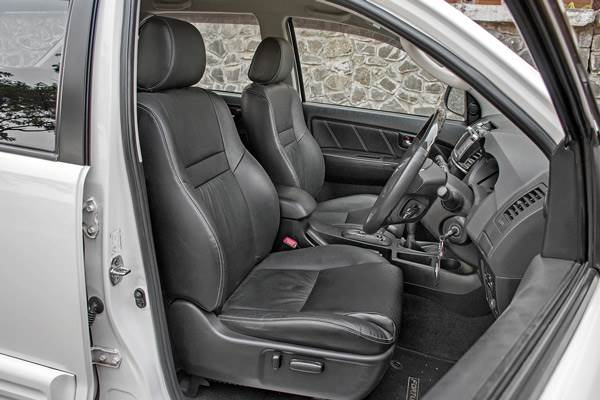
In terms of features, each of these SUVs get modern-day essentials like a touchscreen infotainment system, a Bluetooth telephone function, a reverse camera, automatic climate control, leather seats, a powered driver’s seat and cruise control. Satellite navigation is standard on the Fortuner and Pajero Sport and offered as an option on the Trailblazer and Endeavour. However, the Ford, in top-spec Titanium trim, goes one up on the others with a panoramic sunroof, automatic wipers, a powered tailgate as well as powered fold function for the third-row seats. The Ford’s also got parallel park assist that will steer the SUV into a detected parking spot. There’s Emergency Assist too that will automatically use a synced phone’s mobile network to alert emergency services in the event of a collision. Speaking safety, the Endeavour also has seven airbags where the others get two.
People movers
All of these SUVs come with seven seats but they offer varying levels of comfort for those seated in the second and third rows. The Endeavour’s middle-row seats are a touch low but the seating position is quite nice. Unfortunately, taller occupants will find headroom just about adequate on the panoramic sunroof-equipped top-spec Titanium version Endys. The lower roof lining at the sides (to accommodate the roof’s sliding mechanism) is to blame for this. Those seated in between will also have to contend with a high central tunnel. Third-row occupants also don’t have it nice in the Ford. Access is poor, space is tight and the seating position is plain uncomfortable for adults.
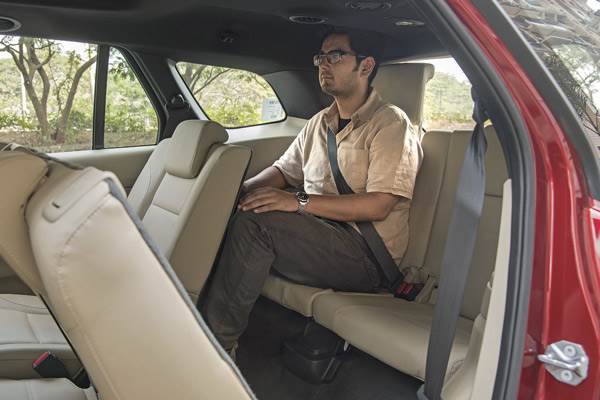
The Trailblazer, in contrast, has the most useable third row. Sure, space isn’t great and access is just average but the seating position is more than tolerable for short stints. The Trailblazer also has the nicest second row. The seat cushioning is well judged, there’s plenty of head, knee and shoulder room and the flat floor means even the middle passenger is well catered to. Interestingly, the Trailblazer is the only SUV here that doesn’t let you slide the middle-row seat back to increase legroom.
You won’t find the Fortuner lacking in middle-row space either. The seat is reasonably comfortable so you won’t mind spending time in the back. Average-sized adults can also make use of the Fortuner’s third row for short hops so long as they can make their peace with the limited headroom and restricted view out.
The Pajero offers the best visibility from the third row and also the best access thanks to the single-lever operation to move the middle row out of the way. Unfortunately, the knees-up seating position and tight headroom severely restrict usability. The second-row seats are far nicer so long as you don’t need to travel three abreast; shoulder room is significantly down on rivals.

With all seats up, the Fortuner offers the most room for luggage though, like the others, you’ll have to fold its last row of seats to be able to fit in large suitcases and the like. Speaking of which, the Endeavour is the only SUV to feature powered operation for the last-row seats, which is a feature you’d usually only find on luxury SUVs.
Power up
Since we’re talking automatics and it’s likely that owners would be doing the bulk, if not all, of the driving themselves, performance becomes as big a deciding factor as any. And it’s here that the Chevrolet Trailblazer sets itself apart from the others. It’s the only one of these models to do the 0-100kph dash in under 10 seconds which is remarkable for a towering SUV that weighs over two tonnes. It’s significantly quicker than the others from 20-80kph and 40-100kph too. Of course, key to the Trailblazer’s numbers is its four-cylinder, 2.8-litre Duramax engine and the strong 197bhp (at 3,600rpm) and 50.9kgm (at 2,000rpm) that it makes. The Trailblazer’s engine always feels eager and quick to build speed from low revs. It is the most entertaining of the engines and what helps the overall experience is that the six-speed gearbox is also quick to respond to manual gearshift inputs. The Chevy engine can get loud when revved though.
Of these SUVs, the Ford Endeavour is the odd one out in its use of a five-cylinder diesel engine. Its 3.2-litre motor is the largest but it only matches the Trailblazer’s 197bhp of peak power, though it makes it at a lower 3,000rpm. The max torque of 47.9kgm is also down on the Chevy. Another number to highlight is the Endeavour’s kerb weight. In 3.2 litre 4x4 form it weighs a portly 2,394kg which is the most here, by a huge margin.
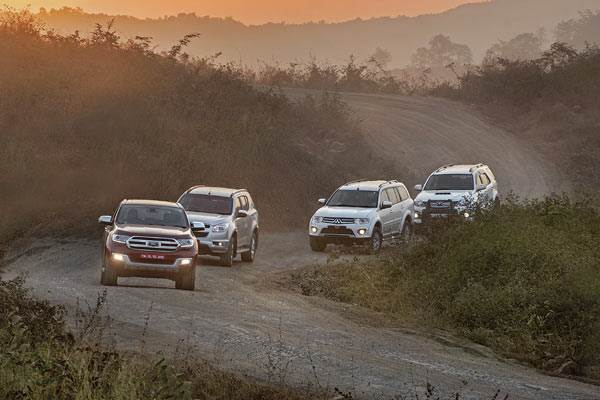
Performance is strong but it makes an impression more for how well it pulls than for how quick it revs. Mild and part-throttle responses are good but when you press down on the accelerator, the six-speed auto gearbox has a tendency to lock at about 3,000rpm until such time the engine catches up. After such point, the engine will rev on to a max of 4,500rpm in nice-to-use manual mode. But doing so isn’t recommended as it will raise the noise level from the engine bay more than the performance level. That said, the Ford’s engine is still the quietest in this company.
On the other hand, the Fortuner’s four-cylinder, 3.0-litre engine is the loudest. There’s a clatter at idle but it’s really the roar from the engine fan that will have you reach out for your ear muffs. On the move, while the engine is quick to respond, the five-speed gearbox occasionally fumbles through the ratios at mild throttle inputs and shifts aren’t absolutely seamless either. But once you pick up speed, the Fortuner gets into its rhythm. In fact, real world performance is a lot better than the numbers suggest and the overall impression is that this is a strong engine. It makes the least power (167bhp) but so long as you are not looking for thunderous performance, you won’t be disappointed.
The big surprise in this group was the Pajero Sport. Its four-cylinder, 2.5-litre engine is the smallest and its 175bhp and 35.7kgm, though impressive for the engine, are also towards the lower end of the spectrum. However, performance numbers are just shy of the 3.2 Endeavour’s; the Pajero’s relatively light weight helps in a large way.
But that’s not all. Its engine has spunk. There’s a good spread of power right from low down in the rev band but what makes it special is how it pulls from 3,000rpm on. The powerband culminates in a proper top-end which is best exploited by keeping the auto ‘box in manual mode and shifting towards the 4,900rpm limiter. The Pajero Sport is also the only SUV to come with paddle shifters and this is only something that will endear it further to enthusiasts.
Rough and tough
You’d be expecting too much if you thought any of these high-riding SUVs would keep you entertained on a mountain road. But the Endeavour comes closest. Its electrically assisted steering is the nicest by far (at all speeds) and grip levels are also superior to all the other SUVs. There’s a genuine Ford-ness to the handling which makes it a reasonably fun big SUV to drive. What’s more, the Endy doesn’t get ruffled by mid-corner dips and bumps either and stability, on the whole, is easily best-in-class. That’s not to say the Endy doesn’t move around at all, but it’s a lot more composed than the others. It’s got the quietest suspension too and best sound insulation which only further distances it from the competition.
The Trailblazer, unfortunately, loses some ground in the ride and handling department. There’s a fair amount of vertical movement and at times, the rear-end will also hop and skip on all but the smoothest surfaces. The Chevy does feel solid and is also confident around corners but there’s no escaping the significant body roll. Around town, the Chevy also feels its size.
That’s true about the Fortuner as well. Its steering is on the heavier side and requires a fair amount of effort at low speeds. The low-speed ride is lumpy too so you can pretty much feel every imperfection on the road you’re on. Things get better as speeds increase with the suspension feeling more absorbent but it’s still far from the Endy’s benchmark standards. It’s a couple of notches down in handling too. Take a corner with verve in a Fortuner and you’ll feel significant weight transfer.
The Pajero isn’t quite the Sport either but the handling is a whole lot more than acceptable. For the most part, the Pajero feels smaller than its size and this gives it some amount of chuckability. There is lots of body roll here too but the feelsome steering does give you a good feeling of control. Unfortunately, at slow speeds, the steering feels heavy and also calls for way too many turns lock to lock. Low-speed bump absorption is generally good but the Pajero will also crash through potholes.
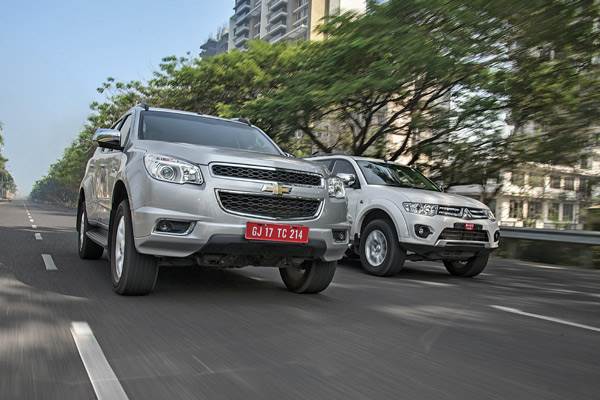
In the wild, the rear-wheel-drive only Trailblazer and Pajero Sport AT are at an immediate disadvantage but you’ll be surprised how far they’ll go before they start losing traction. Of course, if you are serious about exploring the unknown, the Fortuner and Endeavour are the ones you should be interested in. Both SUVs have low-range transfer cases but the Toyota’s mechanical gear type selector feels decidedly old-school and crude. The Endeavour’s rotary dial off-road mode selector is far nicer to use and also more exhaustive in scope – in addition to the off-road hardware, it primes the braking and traction control systems for different scenarios as well. The Endeavour also displays distribution of torque, roll and pitch angles on the instruments screen.
Decision time
It’s as soon as we start tallying the points that the clear victor of this competition starts emerging. We’ll start the elimination process with the Mitsubishi Pajero Sport. Priced at Rs 25.35 lakh (ex-showroom, Delhi), the Mitsubishi is the most affordable of these SUVs. However, to us, its appeal centres around its strong engine and punchy performance. However, there’s no escaping that this is an SUV past its prime. The design has lost its sheen, its cabin looks outdated and space isn’t near the class best. Then there’s the question of Mitsubishi’s commitment to India. Remember, there’s a new Pajero Sport out elsewhere in the world but there’s no word on if and when it will come to India.
Toyota has a new Fortuner as well and we know it’s being readied for launch here in 2017. While that is something to look forward to, it’s a long time for the current model to soldier on, especially in the light of newer competition. The Fortuner has its strengths in its powerful engine, spacious cabin and off-road ability but where it seriously lags behind the newbies is in terms of refinement and quality. It may have a bulletproof image but the fact is the Fortuner doesn’t feel special today, especially for something that costs Rs 27.02 lakh.
The Rs 26.4-lakh Chevrolet Trailblazer is also not cheap, especially for a two-wheel-drive only SUV. To a few, the fact that the big Chevy is not available with four-wheel drive will be reason enough to discount it. But look past its off-road ability (or lack of it) and you’ll find a pretty well-rounded SUV. Performance is really impressive, the cabin has loads of space and it’s the most convincing seven-seater of this bunch. The low-speed ride quality could be better but in almost all other areas, the Trailblazer comes across as a modern take on the age old body-on-frame SUV formula.
But if there’s one SUV that stands out, it’s the new Endeavour. It looks attractive, comes with a well-finished cabin and is loaded to the roof with features. Sure, it’s not the fastest, but it’s quick by class standards. The big Ford is also capable off-road, easy to drive on it and engaging around the bends too. It’s also got the best ride quality hands down and refinement levels are far superior to rivals. Things that work against it include the cramped third-row seating and mediocre middle-row headroom in versions equipped with a sunroof. It’s also priced higher than rivals with the top-of-the-line Titanium version costing Rs 28.15 lakh. But if you look at it in totality, the Endeavour is the one that has moved the game forward which is why it’s the new big SUV of choice.
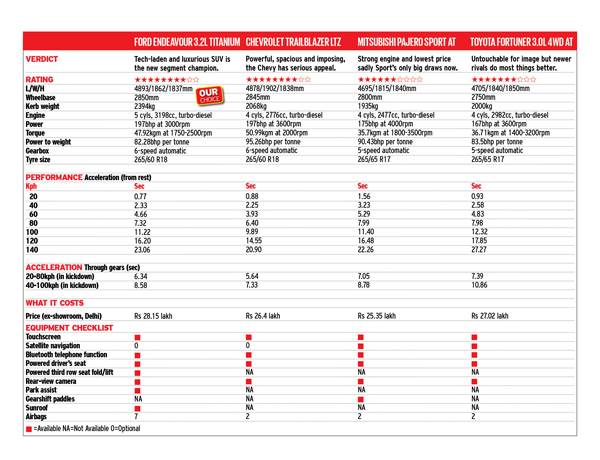

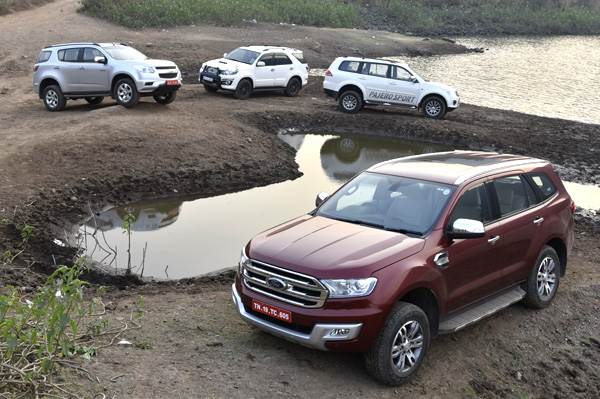
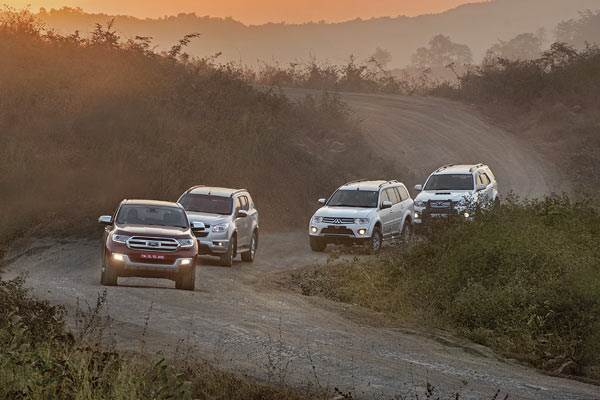

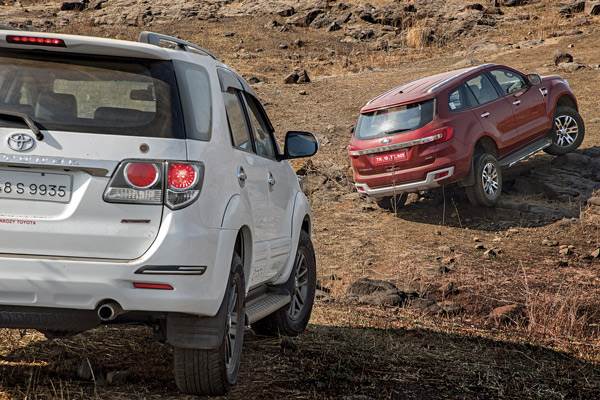


Comments
Member Login
Personal Details
No comments yet. Be the first to comment.